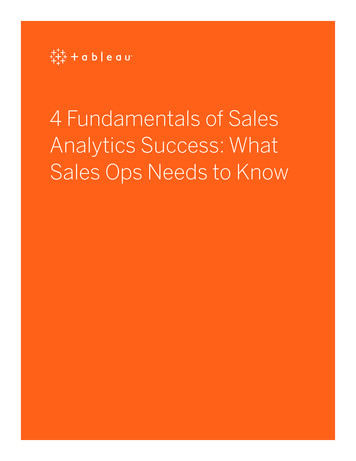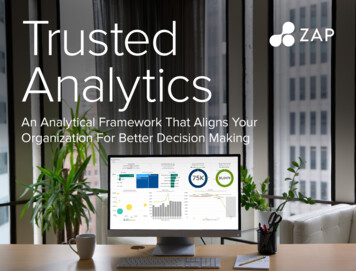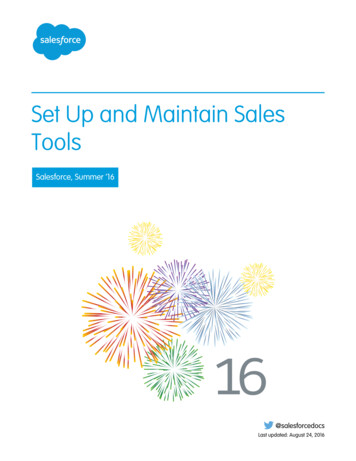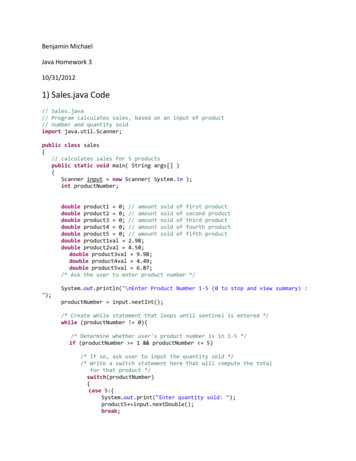
Transcription
4 Fundamentals of SalesAnalytics Success: WhatSales Ops Needs to Know
Does your sales team have the data they need to hit their goals? Are you relying on outdated reports froman array of sources to track progress? Are there information gaps because data is scattered in too manyplaces? In the need-it-yesterday world of sales, no one can afford to wait until the end of the quarter oryear to discover they’ve failed to make quota or meet their customers’ expectations. Stale or missinginformation has consequences—consequences all sales organizations want to avoid.With a clear view into individual and team sales performance it’s easier to make decisions, and ifnecessary, change course to ensure goals are achieved. Sales teams need a platform that brings their datatogether—from all data sources—to answer complex questions from leadership, customers, vendors, andteam members. But for many sales professionals, letting go of familiar routines—including reliance onSalesforce dashboards—is hard.Simply stated, analytics that are quick, easy, and intuitive are critical. A visual analytics platform likeTableau provides a complete view of the metrics that sales operations needs to support better forecasting,planning, and real-time decision making. The ability to integrate customer and marketing data is alsofundamental to understanding selling scenarios and building competitive advantage without slowingyour momentum and progress.So how quickly can your sales team get up and running with an analytics platform? The answer is veryquickly. With features like the newly launched Dashboard Starters in Tableau Online, unified, eyeopening views of data are possible in a matter of minutes—from Salesforce, Oracle Eloqua, Marketo Sales,and more. As you dig in, these are a launchpad into other views of the data depending on what you wishto see.Put analytics into actionSales ops are tasked with knowing all the nuances of their organization’s sales data, and applying thatinsight to boost performance. It’s not a simple task, but harnessing the power of Tableau can make it allpossible. Here are four reasons why.1. Deeper understanding of data helps sales hit numbers fasterIs your understanding of your business limited to what’s in your CRM? And where is your data?In spreadsheets, SQL databases, Hadoop, Salesforce, or other cloud apps? Understanding all sales,marketing, and customer data is essential for discovering insights and making informed decisions. Andbeing able to access data wherever and whenever you need it is just as important.Your sales systems may not capture all transactions. You may not be able to attribute results to4 Fundamentals of Sales Analytics Success: What Sales Ops Needs to Know2
individuals in a team-selling environment or uncover hidden trends with your existing resources. Theways that sales staff input their data varies, and they’re often behind because their primary focus isreally on selling. Ultimately, this oversight can cause inaccuracies or misinterpretation in the data.MillerCoors uncovers sales leads with a real-time view of dataWith more than 450 years of combined brewing heritage, MillerCoors is a U.S.-basedproducer of popular beer brands such as Miller, Coors, Blue Moon, and artisanal hardciders and sodas. Their retail sales team is always on the move, communicating with barsand restaurants, but their culture of Excel reporting made it difficult for salespeople todistinguish which report was correct. Bigger opportunities were missed simply becausethey didn’t have an efficient way of discovering them.In a matter of three months, MillerCoors went from pilot to enterprise deployment ofTableau across a 300-person sales team. With Tableau, the sales team now has a clear viewinto the full spectrum of customers and they can take action when opportunity arises. AMillerCoors salesperson can pull up a dashboard in minutes on a mobile device, offeringa distinct competitive advantage by simplifying communication with their customers.Before Tableau, they had to manually extract data from countless Excel reports—oftenworking through the weekend to understand the data. The team now publishes salestarget dashboards on Tableau Online, creating better visibility, collaboration and healthycompetition among their team of several hundred members.By optimizing Tableau as the single source of truth for sales reporting, MillerCoors isspotting opportunities and selling more product.2. A single source of truth gets your team on the same pageIt’s challenging to build team alignment if everyone is looking at different numbers and data sources.But the benefits of a single source of truth are undeniable. A single source of truth—created when youhave visibility into all of your data—helps managers and individuals see the same big picture and beequally accountable. On top of that, by unifying sales, marketing, and customer engagement data, youcan see details, accelerate decision-making, and gain an extra edge on the competition.4 Fundamentals of Sales Analytics Success: What Sales Ops Needs to Know3
Sales leaders face additional challenges adopting a single source of truth because sales data itself iscomplex. For actionable insights, sales organizations need to be able to analyze key metrics includingterritories, market-sizing, quotas, customer demographics and engagement, and more. While there areways to bring disparate data directly into Salesforce, the process is often slow and painful, and doesn’tsupport the kind of rapid analysis many sales leaders demand. A platform that’s flexible enough toanalyze complex information from multiple places—and aggregate it in one dashboard view—is what’sneeded to give sales leaders the ability to drive strategic, quick business decisions now and in the future.Data transparency uncovers insights and opportunities for LinkedInLinkedIn is an example of a company that needed a robust, scalable platform to gaininsights from their sales data. Their business analytics team adopted Tableau Server tocentralize petabytes of customer data, using dashboards to track performance and predictchurn—creating a more proactive sales cycle and increasing revenue.Before Tableau, LinkedIn stored sales data in internal databases, Google Analytics,Salesforce.com, and third-party tools. Then, one analyst serviced daily sales requestsfrom over 500 salespeople, creating a reporting queue of up to six months, leaving teammembers questioning their performance or wondering where customer relationships stood.Today, 90 percent of LinkedIn’s sales force accesses Tableau Server weekly. With the optionto track overall sales performance and dig deeper to understand the underlying customerexperience, sales can now identify when customers have increased product usage andproactively reach out to them to discuss opportunities or product engagement—potentiallyincreasing overall spend and avoiding account churn.3. Interactive visualizations help you go deeperAs you can see from the examples above, dashboards are important because they allow everyone to seethe same data. They are fast to create and easy to consume—plus, they tell a story that won’t leave salesstaff questioning how to read and interpret the information.Traditional reports and spreadsheets can’t compete with dashboards: they require considerable timeand work to build and maintain, and they lack the insights you get from interactive visualizations.Interactive visualizations enhance basic analytical tasks, such as filtering views, adjusting parameters,4 Fundamentals of Sales Analytics Success: What Sales Ops Needs to Know4
and quick calculations. They also help you examine underlying details with intuitive selections on thedashboard and transform data into actionable insights.Instead of spending time trying to understand data sets, sales can now focus on closing deals, problemsolving and decision making. For Oldcastle, interactivity with Tableau visualizations has transformedtheir data into powerful knowledge that they use to make quick, but important business decisions tobetter serve customers.Tracking 78,000 SKUs helps Oldcastle see the full picture and capture salesopportunitiesOldcastle is a leading manufacturer of building products and materials. With 20 divisionsand 206 facilities across North America, Oldcastle first found success with Tableau bytransforming a 500-page monthly report into a governed dashboard that’s accessibleacross the organization.The Oldcastle sales team spearheads an inventory of over 78,000 stock-keeping units(SKUs) so it’s imperative that they can quickly and easily identify losses, track margins,and seize opportunities. But scaling a solution for the entire saleforce was difficult.Oldcastle can now pull ERP and Salesforce data into Tableau, and the sales team can accessand understand all of their data.Everyone from sales managers to sales representatives consult Tableau dashboards to tracktheir quotas daily and monthly. For a sales team, having access to insights from massivequantities of customer data is empowering and helps them better service customers, too.Paul Lisborg, manager of business intelligence, says “Now a sales rep can come into adashboard, look to what he sold yesterday, look to how he’s doing this month, and look howhe’s doing year-to-date. They can then drill into what customers are doing well, what arecustomers buying, and what their margins are on those items.”4. Dashboards make it easy for your team to collaborateSelf-service analytics are practically mandatory for today’s information-driven sales organizations.The insight-to-decision process must be swift. Gone are the days of relying on IT to build, customize,and publish sales dashboards. Armed with self-service dashboards, sales managers can use them to runpipeline review meetings and sales leaders can work with finance on next year’s strategy. Tableau helpsmodern sales teams put data at the center of every conversation to support real-time collaboration andstrategic decision-making.4 Fundamentals of Sales Analytics Success: What Sales Ops Needs to Know5
Data transparency from self-service analytics elevates Brown-Forman’s globalsales teamTim Nall, chief information officer at Brown-Forman—one of the top ten largest globalspirit companies— believes communication is critical to determining best practices andselling more product. Their teams need insight into pricing and shipping details, so theycan effectively manage stock keeping units (SKUs).Optimizing their existing technology investments in data storage and analytics, BrownForman’s teams are achieving optimal collaboration. “From a global perspective, it isparamount to have all of this information and be able to understand it. Now with whatwe’ve created with our logical data warehouse and Tableau, people can collaborate, and allof that information is accessible,” Tim noted.Tableau Server also makes it simple to publish sales dashboards whether your data is live,or refreshes often. With single sign-on, Brown-Forman has one-click access to dashboardsusing their desktop browsers or mobile devices. Dashboards can even be embedded directlyin your CRM.As you gain experience and learn what your team needs by tracking dashboard viewson Tableau Server, like Brown-Forman, you’ll know what is or isn’t working and cancollaborate to refine the dashboards for better success.A closer lookSee the big picture (and the details) with powerful dashboardsOnce your team sees the same data, they can ask their own questions using the dashboards and easily getanswers to those questions, instead of referring to different sources that may be inaccurate or incomplete.Distance to quotaEffectively managing sales teams means understanding trends and knowing where things are headed at4 Fundamentals of Sales Analytics Success: What Sales Ops Needs to Know6
any given time—but gathering all the critical data is difficult, especially when teams are large or widelydispersed. In this dashboard, the distance from the quota can be viewed by product or opportunity type.And historical data provides additional context and a window into future trends. With Tableau, youreduce the guesswork from sales management.4 Fundamentals of Sales Analytics Success: What Sales Ops Needs to Know7
Pipeline and general performanceUnderstanding historic sales performance is one of the keys to more accurate forecasting. Using Tableau,comparative analysis like year-over-year growth can be done as a single calculation. You can see yourperformance historically, cumulatively, and for each business group. It’s also easy to blend Salesforcedata with product data to understand trends and new opportunities by region.4 Fundamentals of Sales Analytics Success: What Sales Ops Needs to Know8
Keep an eye on profitabilitySales doesn’t always mean profit. Sales ops is in a unique position to help your team find the right dealsto close—deals that lead to net income and positive cash flow for the company—not deals that createunsupportable overhead. This dashboard shows sales and profit by segment, product line, and region,allowing sales leaders to quickly identify and take action to address any unprofitable selling activity.Using visuals to look at seasonal trends gives you the ability to predict future trends, forecast, and planappropriately. You can also make decisions by applying data for historically slow quarters, summerslowdown, and end-of-year sales explosions. By having the same calendar month’s results stacked nextto each other, it’s easy to see cyclical trends that influence sales going up or down.4 Fundamentals of Sales Analytics Success: What Sales Ops Needs to Know9
Are you ready to maximize the possibilities ofyour data?Sales organizations need a steady stream of actionable data in order to remain competitive, satisfytheir customers, and determine where they need to focus their next initiatives. Staying ahead in adynamic sales environment also means being future-facing. With a data platform that is flexible andpowerful enough to analyze all of your sales data, you’ll be ready to leverage the potential of emergingtechnologies such as artificial intelligence, machine learning, and more.If you’re already using sales dashboards, evaluate how your data insights compare with Tableau. Weinvite you to learn more by following the resource links listed below.4 Fundamentals of Sales Analytics Success: What Sales Ops Needs to Know10
About TableauTableau helps people transform data into actionable insights. Explore withlimitless visual analytics. Build dashboards and perform ad hoc analyses injust a few clicks. Share your work with anyone and make an impact on yourbusiness. From the individual analyst looking at specific sales performance tothe sales executives looking at overall performance in the pipeline and abilityto hit targets that meet company goals, people everywhere use Tableau to seeand understand their data.Related Materials Sales Ops Starter Kit – Everything you need to get up and running withTableau for your sales department. Tableau’s Sales Analytics Solutions Page – A one-stop resource tounderstand how Tableau helps sales professionals see and understanddata. MillerCoors Sales Analytics Case Study – This beer brand establishedone source of truth for sales reporting, increasing visibility to spotopportunities and sell more product.Explore Other Resources Product DemosTraining & TutorialsCommunity & SupportCustomer StoriesSolutionsTableau and Tableau Software are trademarks of Tableau Software, Inc. All other company and productnames may be trademarks of the respective companies with which they are associated.
4 Fundamentals of Sales Analytics Success: What Sales Ops Needs to Know 3 individuals in a team-selling environment or uncover hidden trends with your existing resources. The ways that sales staff input th










